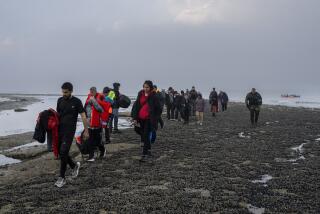Malta guards Europe’s gates against African immigrants
- Share via
Reporting from Valletta, Malta — When the 24-year-old Somali chemistry teacher saw the airplane overhead, he prayed that his nightmare journey was finally over.??
Already, he had made a grueling journey through the desert and then spent seven months in a crowded Libyan prison cell surrounded by sickness and death. Now, the rickety fishing boat carrying him and 167 other migrants was no match for the rough Mediterranean waters and he feared the current would pull it back to Libya.??
The airplane didn’t come back, and it would be six more days before a Philippine freighter rescued the migrants and brought them to Malta, where he would spend 10 months in detention before being granted a form of temporary refugee status given to people fleeing war zones.??
Although the teacher has found a job working as an interpreter for a local refugee advocacy group, without permanent status he doesn’t feel like he can build a life in Malta and hopes to eventually be resettled somewhere else in Europe or the United States. ??
“Now I’m stuck here; can’t go forward, can’t go back,” he said. ??
As a member of the European Union, Malta is obligated to grant asylum to individuals who qualify, but the country maintains one of the strictest detention policies in Europe. Migrants who enter illegally can be held up to 18 months while their cases are processed; the Somali teacher’s story is not uncommon.??
Most asylum seekers who end up in Malta on boats from Libya are trying to go farther north to Italy, where they believe there are job opportunities and where some hope to be granted asylum. Many are hoping to avoid detention and slip over the border toward northern Europe.??
“Nobody was planning on coming to Malta,” the teacher said. “We all bought new clothes for when we landed in Italy so we could just go and disappear.”??
An increase in illegal immigration has led countries such as Malta and Italy to boost coordination with Libya in search and rescue operations as well as with the signing of several agreements to crack down on smuggling networks.
The result has been a dramatic decrease in the last year in the number of boats from Libya arriving in the two countries. But tightened restrictions have raised concern that those with legitimate claims are being denied access to territories where they could seek asylum. ??
Attempts to control the flow of migration via Libya to Europe highlights the paradox at the heart of the asylum system: Many of those in need of protection have no means of legally entering countries that grant asylum and are forced to resort to dangerous, illegal routes.
When European countries that offer asylum tighten their borders, these routes become even more perilous, prices for smuggling go up, and many people who could qualify for refugee status are left trapped in Libya, where they live in constant fear of arrest and torture.??
“It’s useless to say ‘Yes, we grant asylum’ if people cannot gain access to territory where they can apply for protection,” said Father Joseph Cassar, director of the Jesuit Refugee Service office in Malta, which offers legal, medical and social assistance to refugees.
Tens of thousands of migrants from across Africa have risked their lives over the last decade trying to reach Europe. Many are fleeing violence in Somalia, Eritrea and Sudan, while others, mostly West Africans, are hoping to escape poverty.
According to international refugee law, only those who can prove personal persecution are granted full refugee status. These refugees are resettled either in the country in which they applied for asylum or a second nation that agrees to take them, at which point they can apply for family reunification. The United States will accept several hundred refugees processed in Malta this year.
Many, like the young Somali teacher who left because of the violence and instability in his homeland, are granted “subsidiary protection” status, which must be renewed every year. Given his uncertain position, coupled with the trauma he has endured, he asked that his name not be published.
“We were 168 people in a boat that was supposed to be for 100,” he said. “We saw an aircraft so we put the children up on the deck to wave.”
Several incidents have drawn criticism from the Office of the United Nations High Commissioner for Refugees and other human rights organizations, which allege that boats are being pushed back or handed over to Libyan patrol ships by Maltese and Italian authorities even if it means delaying rescue operations.
In July, Malta was criticized after 27 of 55 people rescued during a joint operation were returned to Libya. The Maltese government maintains that the 27 people “volunteered” to be sent back, a claim the UNHCR spokesperson in Rome called “not credible and scarcely realistic.” In retaliation, Libya shut down the UNHCR office, further limiting the agency’s ability to assist asylum seekers.
The immigrant influx poses a challenge for Malta, an island nation of 400,000. At the peak of migration in 2008, 84 boats carrying 2,775 people landed here or were brought in after rescue.
Despite Malta’s unique blend of Arab, Italian and British influence, it remained relatively insular until it joined the European Union in 2004, which coincided with an increase in the number of asylum seekers from Africa after outbreaks of violence in Somalia, Eritrea and the Sudan.
Maltese anxieties over national identity resemble similar debates in France and Italy.
Maltese officials say they grant some form of protection to more than half of those who apply, a higher recognition rate than most countries. They point out that crossing from Libya to Malta by boat is dangerous, and shutting down the illegal sea route means fewer lives lost at sea. With valid travel documents, migrants would be able to fly.
“We were finding corpses at sea and this is the consequence of human smuggling,” said Joseph St. John, director of policy development at the Maltese Ministry of Justice and Home Affairs. “They charge over $1,000 and cram as many people as they can into a boat. We’ve found 60 people in a [100-foot] inflatable boat.”
More to Read
Sign up for Essential California
The most important California stories and recommendations in your inbox every morning.
You may occasionally receive promotional content from the Los Angeles Times.










